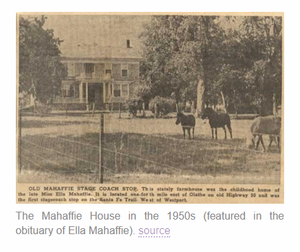Farm History:
The Mahaffie Stagecoach Stop & Farm house is the only known Santa Fe Trail stage station that remains open to members of the public (National Park Service, 1989). Originally established by James "Beatty" Mahaffie in 1858, the farmstead was home to his wife Lucinda (Henderson) Mahaffie and their eight children through the mid-1880's. Arriving from Logansport, Indiana by wagon in November 1857, with five of their eight children and an orphaned nephew, the Mahaffies purchased a modest lot with a small wood frame house in Olathe, Kansas (est. 1857). and spent the winter (Pankratz, 1977) in town. In the spring of 1858, J.B. Mahaffie acquired an initial 160-acre land warrant from the estate of Benjamin Reynolds for $600 in gold (National Park Service, 1989) approximately a mile northeast of downtown Olathe. This particular tract, located on the “Westport Route” of the Santa Fe Trail, (About Us, 2024) had originally been awarded to James Raye as a land grant from the United States for his service in the Mexican-American War of 1812 (National Park Service, 1989). The acreage was held in the estate of Benjamin Reynolds, from which Beatty acquired the property.
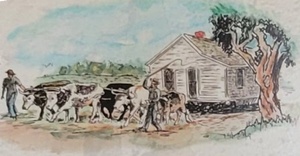 Art relief courtesy of Mahaffie Stagecoach Stop and Farm Historic Site museum .
Art relief courtesy of Mahaffie Stagecoach Stop and Farm Historic Site museum .
Using a team of oxen to move their home from in town, Mahaffie had the wood frame structure relocated to its permanent residence on what would become known as the Mahaffie Farm. By the end of 1858, Mahaffie added another 160 acres along the north edge of the original purchase, totaling 320 acres. In 1860, Olathe's population was 341. Over the next seven years, the small family would experience the Missouri-Kansas Border War, a prelude to civil war in 1861, Quantrill raids, from 1855-1861 and the Civil war from 1861-1865. During these years, especially in 1862, with Quantrill's attacks on Olathe, the community's growth slowed. According to local lore, Beatty Mahaffie purchased land from those residents who chose to leave Olathe in the wake of the violent Quantrill Raiders, growing his holdings to over 500 acres. After the Civil War, Olathe's growth resumed and by 1870, the population of Olathe stood at 2047 residents.
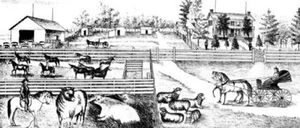 ”Stock Farm and Residence of James Mahaffie” from the 1874 Johnson County Atlas
”Stock Farm and Residence of James Mahaffie” from the 1874 Johnson County Atlas
In 1865, the average Johnson County farm contained 177 acres. Between 1860 and the early 1870’s, the Mahaffie holdings had grown to more than 570 acres (Downtown Olathe History, 2024), with portions of the land sections located across multiple counties. The main farmstead had cemented itself as one of the most prosperous farms in Johnson County. Besides the sale of produce and crops, the Mahaffie family also sold surplus farm supplies. As recorded in the 1865 Kansas Agriculture census, the value of farm implements in Johnson County averaged $148. The value of the Mahaffie Farm implements was $435. In addition, the average farm cash value was $1670, while the value of the Mahaffie’s was $6000 and rose to $12,000 by 1870. (About Us, 2024)
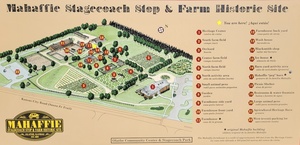 Mahaffie Grounds Map - courtesy of the Mahaffie Stop & Farm Historic website - Mahaffie.org
Mahaffie Grounds Map - courtesy of the Mahaffie Stop & Farm Historic website - Mahaffie.org
Per the lists in the Kansas state agricultural census of 1875, the farm supported 112 acres of orchard trees. In 1859, it was considered the first successful commercial farm in Johnson County (Etzel, 2021). In that same year, the wheat from the Mahaffie farm was the first in Johnson County to be sold to the Washington flouring mill in Wyandotte. (Richardson, 1907). By 1870, Mahaffie had also established the Farm as a Stock Farm with an estimated 50 head of cattle in addition to its milking cows and oxen. An advertisement in an 1881 edition of the Olathe Gazette attested to the quality of beef raised on the farm by the Mahaffies, “Everybody says they kill Good Beef at Mahaffie Bros.” (Staff, 1881). Spanning the twenty years from 1860-1880, immediate and related Mahaffie family members worked to support their agriculture and hospitality ventures. However, according to the Federal and state census during that time, additional help was hired to aid in farm chores, domestic household duties, as well as, caring for travelers and guests. Although slavery was legal until 1860, all of the hired hands were paid as employees. There is no record of the Mahaffies ever owning slaves.
Although stories allude to the Mahaffies serving travelers from their first home as early as 1858, (About Us, 2024), the Mahaffie Farm officially expanded into hospitality in 1863, when the Barlow, Sanderson and Company Stagecoach Line contracted with the Mahaffie family to establish a critical stagecoach stop along the Santa Fe trail for the westward bound travelers. Touted as the first hotel and stage station in Johnson County (Richardson, 1907), the Mahaffies provided food and respite for stage coaches carrying passengers and, in some cases, mail between Fort Scott and Fort Leavenworth, and from Independence, Missouri all the way to Santa Fe, New Mexico (About Us, 2024).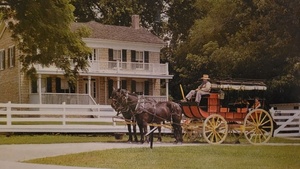
Late in 1865 through early 1870, stagecoaches would pull along the west side of the house, allowing passengers and other hungry travelers to disembark and take their meals in the basement of the “new” stone farmhouse. Accessing through exterior cellar doors, guests would descend into a newly fashioned dining hall and kitchen. (About Us, 2024).
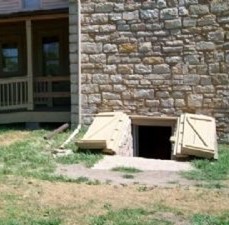 Exterior entrance into the Mahaffie dining hall
Exterior entrance into the Mahaffie dining hall
Between 1866 and 1867, Lucinda, her daughters, and hired helpers purportedly served between 50 to 100 meals a day to visitors. While they ate, incoming teams of horses were switched for fresh animals. (About Us, 2024).
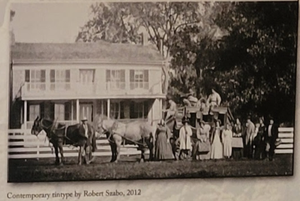 Contemporary tintype by Robert Szabo, 2013, courtesy of Mahaffie Stagecoach Stop and Farm Historic Site museum .
Contemporary tintype by Robert Szabo, 2013, courtesy of Mahaffie Stagecoach Stop and Farm Historic Site museum .
The Mahaffie Family: James ‘Beatty’ Mahaffie, born in Fayette County, Ohio, April 25, 1817, married Lucinda Henderson (b.Oct 14, 1827) on April 25, 1844 (staff, 1903). According to the state and federal census taken in 1860 and 1870, Mahaffie self-identified as a farmer. However, he was also a key member of the first board of county commissioners, helping to make Olathe the county seat of Johnson County. He was a founding charter member of the Olathe Grange, a fraternal organization devoted to the rights and interests of farmers. The Grange was also among the first of its kind to admit men and women on an equal basis. Both James and Lucinda helped to establish the Olathe Grange Chapter in 1874.
When the railroad arrived in Olathe in 1869, which Beatty was instrumental in bringing to the community, stagecoach operations for the Mahaffies slowed until they ceased altogether by the end of 1870. (About Us, 2024) Beatty, along with two other investors, became incorporators of the Kansas and Neosho Valley Railroad, which was shortly there after absorbed by the Kansas City/Missouri River, Fort Scott and Gulf Railroad. Serving on the board of directors of the original organization, until replaced by Boston businessmen, Beatty remained steadfast in assuring Olathe's permanent place on the map (Richardson, 1907). From the early years of his residency, Beatty was active in politics, including serving as the elected county supervisor in 1858. Unlike his fellow councilmen and Republican peers, James Mahaffie registered and remained a northern Democrat throughout his life. However, with the turbulent years during the Civil War and most of Olathe becoming staunch Republican, Beatty dropped out of politics rather than change his political affiliation.
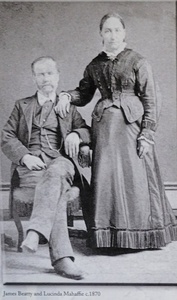 James and Lucinda Mahaffie, 1870, , courtesy of Mahaffie Stagecoach Stop and Farm Historic Site museum .
James and Lucinda Mahaffie, 1870, , courtesy of Mahaffie Stagecoach Stop and Farm Historic Site museum .
After their arrival in Olathe, James and Lucinda had three more children. Over a twenty-four-year period, the Mahaffie’s legacy included two daughters, Isabella (“Bell”) and Susan Effie Ann (Effie) and three sons: William Aiken, John Henderson, and George Barkley. The three Olathe born additions included James Franklin (“Frank”) 1860, Andrew Murkle (1865), and Ella Monita (1869) when Lucinda was forty-one years old. Seven of the eight children survived through adulthood. Andrew Murkle died at twenty-one months old, in 1867. 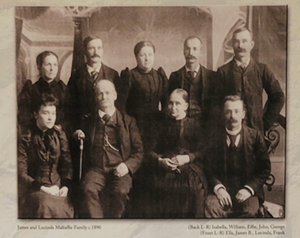 James and Lucinda Mahaffie's Family 1890, property of Mahaffie Farm and Stagecoach Stop Historical site museum.. Seated (Back L-R) Isabella, William, Effie, John, George. (Front row L-R): Ella, James B., Lucinda, Frank
James and Lucinda Mahaffie's Family 1890, property of Mahaffie Farm and Stagecoach Stop Historical site museum.. Seated (Back L-R) Isabella, William, Effie, John, George. (Front row L-R): Ella, James B., Lucinda, Frank
By the mid-1880’s, James and Lucinda retired from farming and moved in town, buying a home in Olathe, where they would remain until their deaths. The couple enjoyed another 20 years together before Lucinda passed away on May 25, 1903, and Beatty on October 13, 1907. Both lay at rest in the Olathe Memorial Cemetery just a few miles away from their farmstead. None of the eight children chose to continue running the farm and it was subsequently sold to James Stilley in 1886. The farm changed hands thirteen more times until the 1970s, when the Mahaffie Stagecoach Stop and Farm was added to the National Registry of Historic Sites (Pankratz, 1977). In 1979, the Mahaffie home, its adjoining property and 20 acres of the original 320 was purchased by the city of Olathe for preservation. The The Mahaffie Stagecoach Stop & Farm Historic site is managed and operated by the City of Olathe’s Parks and Recreation Department. The site is also designated an official component of the Santa Fe National Historic Trail by the National Park Service and a partner site of Freedom's Frontier National Heritage Area.
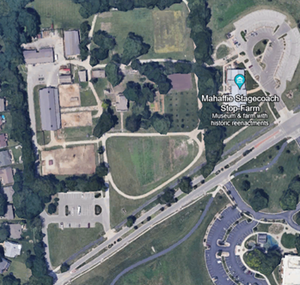 Google Earth's aerial view of the Mahaffie Farmstead and Museum, which is located just east of the Mahaffie House
Google Earth's aerial view of the Mahaffie Farmstead and Museum, which is located just east of the Mahaffie House
Both James and Lucinda were considered pioneers, progressive, generous and above all welcoming. Reputed for devoting their 50+ year constituency to their community, benefactors of the Santa Fe Trail preservation, and solidifying Johnson County as an agricultural and transportation hub, the immortalized bronze reliefs of the Mahaffies will forever represent a lifetime of kindness and good will towards neighbors and strangers alike. 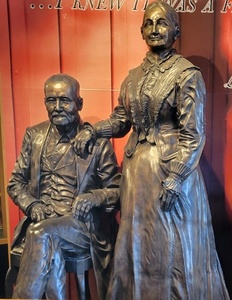 Bronze statue of James and Lucinda Mahaffie on display at the Mahaffie Stagecoach Stop & Farm Historic Site's Visitor Center
Bronze statue of James and Lucinda Mahaffie on display at the Mahaffie Stagecoach Stop & Farm Historic Site's Visitor Center
Mahaffie House: The original “J.B. Mahaffie House” as recorded in the National Registry listing (Pankratz, 1977) was a one and a half story, five-room wood-frame structure that Mahaffie commissioned for $200 in gold in 1857 (Pankratz, 1977), which was the home moved by oxen. By 1865, a two-story native limestone addition was completed on the south side of the existing wooden home. Located 500-600 feet north of Kansas City Road, the vernacular style house measures 40 feet along the front, 44-feet along the east and west sides and 32-feet along the back, wooden façade. The two-foot stone blocks used in its construction were taken from a quarry on the property.
 Mahaffie Home and Ice house (on the west side) (2024)
Mahaffie Home and Ice house (on the west side) (2024)
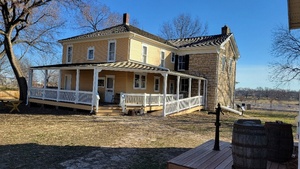 The back (North) side of the Mahaffie Home (2024)
The back (North) side of the Mahaffie Home (2024)
Mahaffie Ice House: Built just to the west of the main house and also completed in 1865, a limestone ice house was constructed to store ice into the summer months. When weather permitted, ice blocks or “cakes of ice” were cut from rivers and lakes, then transported and packed in sawdust or straw during the winter months to help refrigerate perishables at the farm like milk, cheese and other dairy products in the warmer summer temperatures. According to the 1865 Kansas State agriculture census, the Mahaffie farm produced 600 pounds of butter in 1864.
 Mahaffie Ice House located west of the main home
Mahaffie Ice House located west of the main home
Today, the majority of the staff that supports the site is made up of volunteers. The house, museum, visitor's center and grounds are open the public Monday-Saturday 10a-4p. Activities vary seasonally. During its living history events, visitors may tour the house, meet a cook in the cellar kitchen, visit and blacksmiths as they work and enjoy stagecoach rides around the farm. Their animals, including horses, goats and chickens reside on the farm year round, Demonstrations and reenactments involving immersive experiences, period yard games, youth friendly learning camps, and self-guided museum exhibits of a by gone era, are designed to transport all guests and welcomed visitors to life of farming on the prairie.
For a listing of the latest events and available services, please access Mahaffie on Facebook or visit the website: https://www.mahaffie.org
Site Location: 1200 E Kansas City Road, Olathe, KS 66061 (situated between Two Trails Park and Olathe North High School)
References:
About Us. (2024). Retrieved from Mahaffie Stagecoach Stop and Farm Historic Site: https://www.mahaffie.org/about-us
Alcock, N. (2003). Vernacular architecture [Folk architecture] . Retrieved from Grove Art Online: xfordartonline.com/groveart/display/10.1093/gao/9781884446054.001.0001/oao-9781884446054-e-7000088875#oao-9781884446054-e-7000088875
Downtown Olathe History. (2024). Retrieved from Olathe Kansas: https://www.olatheks.gov/residents/community-resources/downtown-olathe/downtown-olathe-history
Etzel, A. (2021, Apr 29). Life in Living History At Mahaffie Stagecoach Stop and Farm. Retrieved from Kansas! Magazine: https://www.travelks.com/kansas-magazine/articles/post/life-in-living-history-at-mahaffie-stagecoach-stop-and-farm/
Grounds Map. (2023, July). Retrieved from Mahaffie Stop & Farm Historic Site: https://www.mahaffie.org/visit/grounds-map
National Park Service. (1989). Santa Fe National Historic Trail Draft Comprehensive Management Plan. Denver, Colorado: U.S. Department of the Interior.
Pankratz, R. (1977). J.B. Mahaffie House. Topeka, Kansas: National Register of Historic Places Inventory/Nomination Form. Topeka: Kansas State Historical Society.
Richardson, J. W. (1907, Oct 7). J.B. Mahaffie. The Olathe Mirror, p. 1.
Staff. (1881, Nov 24). Olathe Gazette, p. 3.

